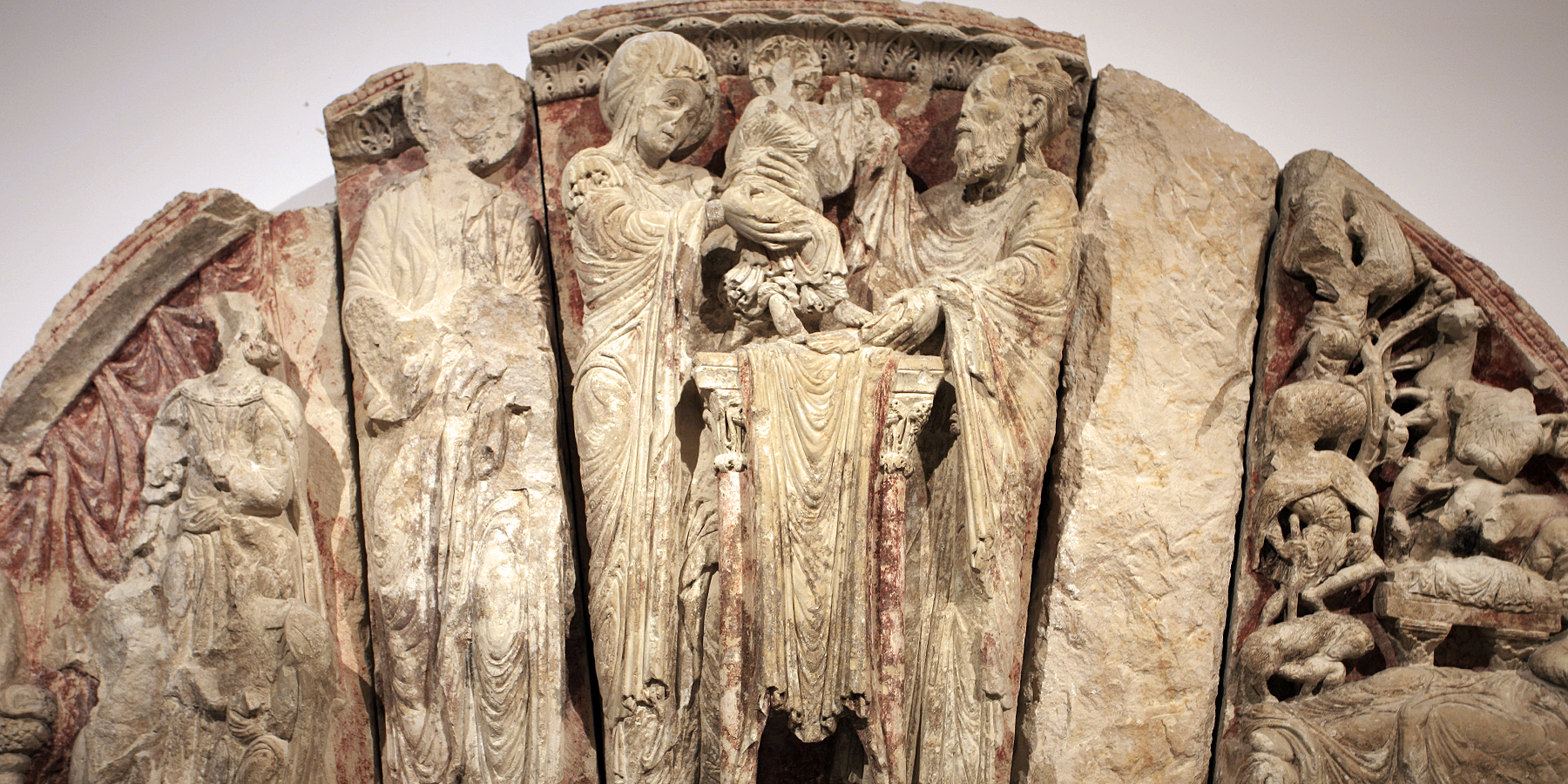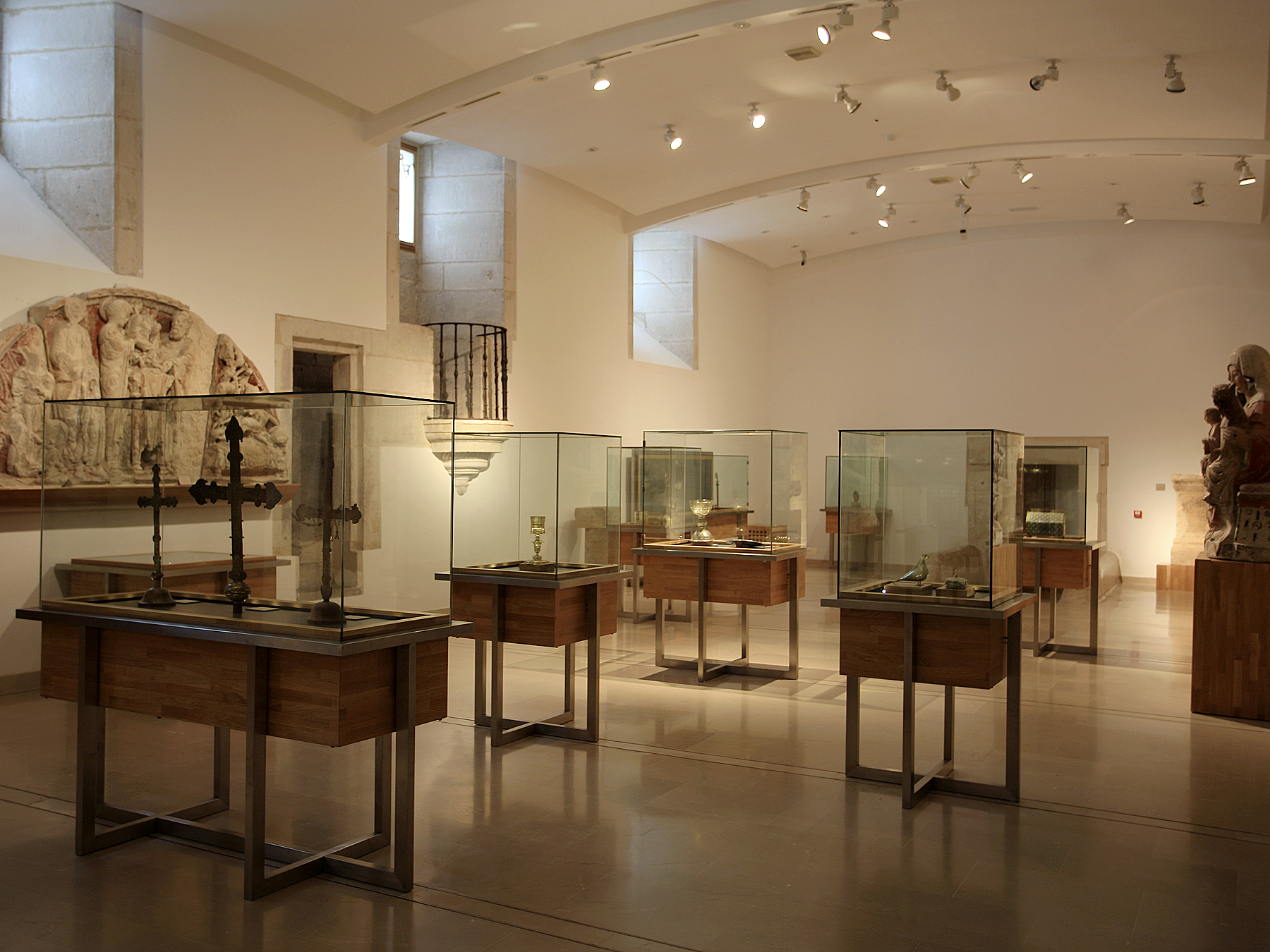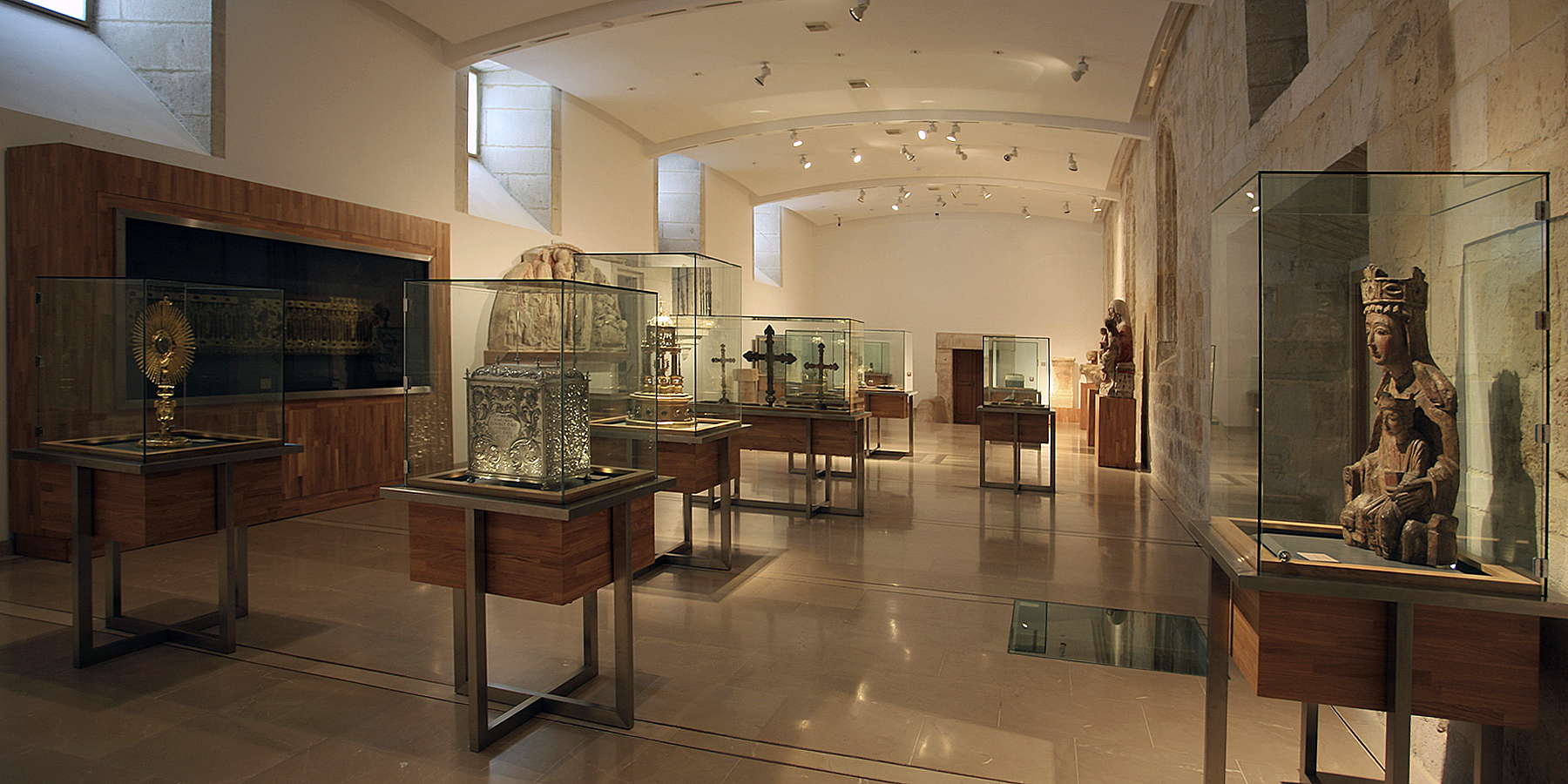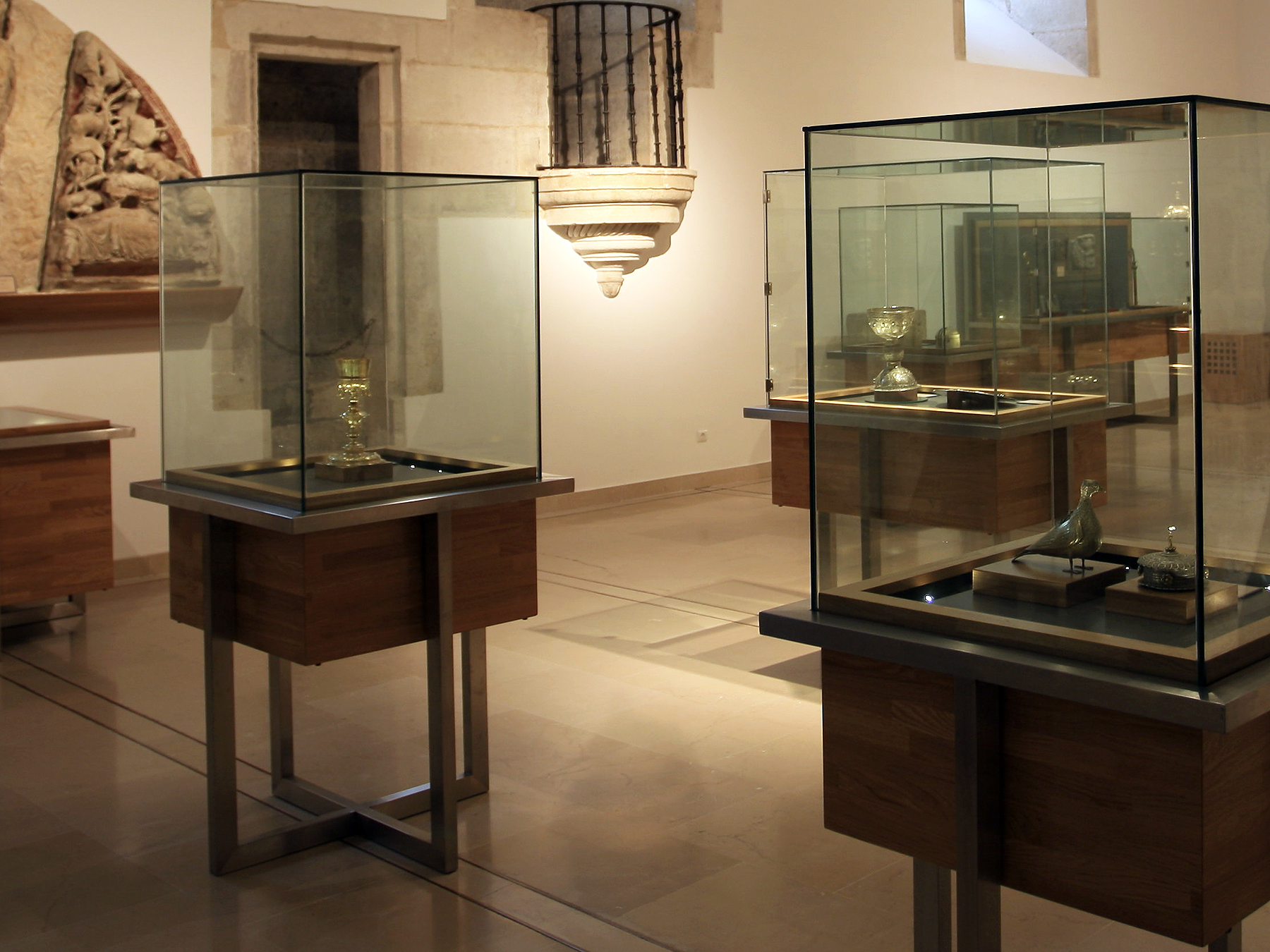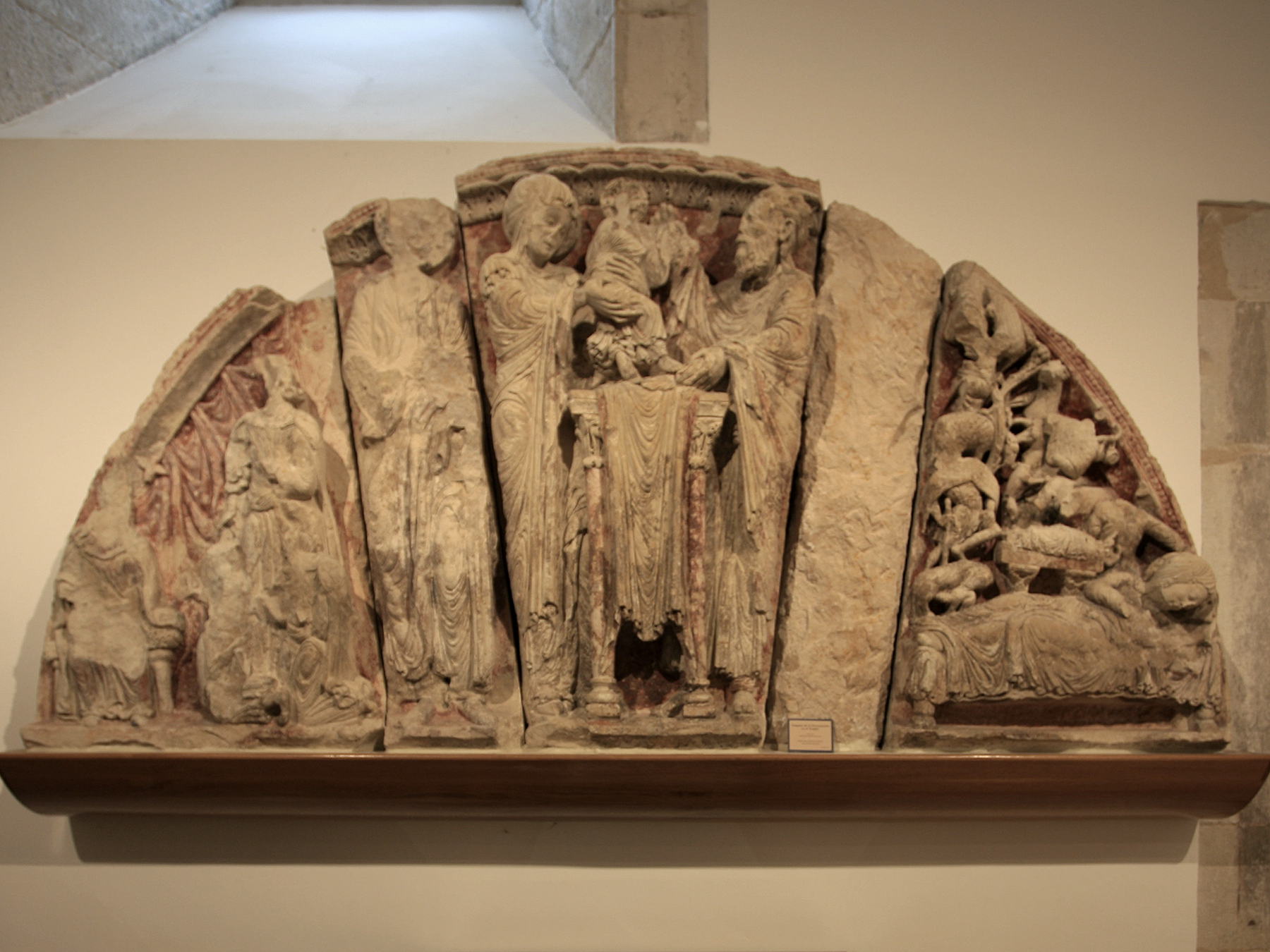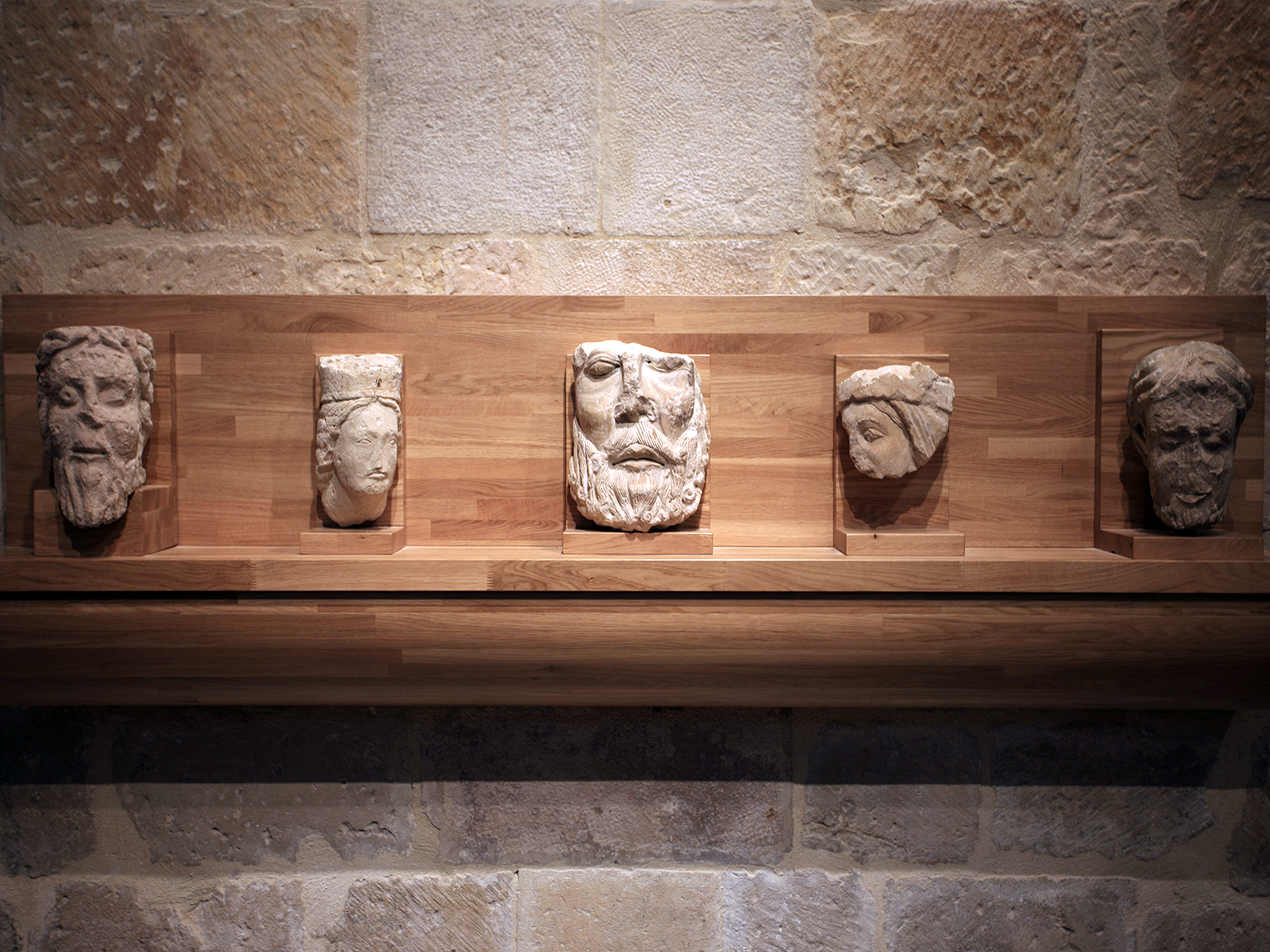Located in an 18th-century room adjoining the southern side of the cloister, this was originally the refectory or dining room of the monastery, restored and fitted out for this new function. It conserves several works saved from the dispersion of the monastery’s belongings during the Ecclesiastical Confiscation and pieces recovered during the archaeological work carried out in the abbey. All of them complete the information on the history of the monastery and attest to its importance as a centre of artistic creation.
The most outstanding collection on display consists of a series of pieces that are thought to have formed part of the so-called Treasure of the Monastery of Santo Domingo de Silos. They historically had a specific liturgical purpose or were containers for relics, all with an important symbolic meaning and made of noble materials of high artistic quality.
A number of works from the monastery that have been kept in the Museum of Burgos since 1869-1870 are mentioned, as they are essential references for assessing the importance of Silos as a centre of artistic creation.
CHALICE OF SAINT DOMINIC. MUSEUM OF SANTO DOMINGO DE SILOS
This was used in the liturgy as a ministerial chalice for distributing communion accompanied by consecrated wine, explaining why it is so large. It is made of gilded silver, and its entire surface is decorated. The cup and base are two half-spheres, joined by a cylindrical shaft with a central spherical knot or handle. The decoration on the goblet and the base have the same composition – an arcade of twelve horseshoe-shaped arches supported by pillars, inside which is a silver droplet, to which a schematic leaf is added to the arcades at the foot of the chalice. Several decorative bands frame these arches and the surface of the knot. All the decoration is crafted from filigree, small threads or cords that form spirals and sinuous elements.
The ribbon bordering the hemisphere at the base bears an inscription indicating that it was made by Abbot Dominic in honour of Saint Sebastian, the saint to whom the monastery was dedicated. The chalice was made in the monastic workshop and is dated between 1041 and 1073, the period when Dominic was abbot. It is an exceptional piece of gold work from this historical period and a symbolic representation of the magnificence and power of the monastery.
THE SAINT’S PATEN. MUSEUM OF SANTO DOMINGO DE SILOS
This is called the “The Saint’s Paten” because it was used alongside the Saint’s chalice, but it is dated to later than 1440. A catalogue of relics from that year mentions the body of Saint Dominic, the chalice, the chasuble and the crosier, but does not mention the paten, so it must be dated to the 15th-16th century. The central part consists of eight semicircular alveoli framing a large circular rock crystal cabochon.
The wide rim of the plate is decorated with wavy filigree motifs and a cluster of cabochons or gemstones of varying sizes. There are four large cabochons forming a cross, between which are eight smaller ones, making a total of thirty-two stones reused from earlier works. The main cameo, made of agate from the Lower Imperial Roman period – late 3rd to 5th centuries AD – depicts a female face in profile looking to the left while at the opposite end is another dark-blue agate dated to the 2nd century. Among the small cabochons are two carved pieces from the Roman period with iconographic representations, while the rest are made of rock-crystal, agate, turquoise and other hard stones.
PIGEON AND FEMALE HEAD. MUSEUM OF SANTO DOMINGO DE SILOS
According to historical references, these two pieces are linked by their function and symbolism. In the monastery’s aforementioned 15th-century catalogue of relics, it is mentioned that there was a votive crown placed on the main altar of the church, made up, among other pieces, of “a dove on the head”. A female head and a Eucharistic dove have survived from among its hypothetical components. The Roman-period head is made of bronze, historically considered to be an idol from Carazo, but probably from the city of Clunia. It is chronologically catalogued as dating from the 3rd to 4th centuries AD. Inside it contained various relics, thus Christianising an artefact considered to be of pagan origin.
The Eucharistic Dove is so called because it has a receptacle on its back, featuring a little door behind which the Eucharistic was kept. In the 15th century, it no longer had this function and, according to the aforementioned inventory, it contained several relics. It is made of gilt silver, cast in one piece except for the head, with chiselled and engraved plumage. It dates from the second half of the 13th century.
ABBOT’S CROZIER. MUSEUM OF SANTO DOMINGO DE SILOS
This is a symbol of the spiritual and jurisdictional power of the Abbot of Silos. It is executed in gilded, engraved, carved and enamelled copper. The crozier was found in the 1960 archaeological excavation of the tomb of Abbot Juan Gutierrez II, who died around 1198. The scroll of the staff is decorated with Niello silver scales and rings and ends in a dragon’s head with a lapis lazuli appliqué in one of its eyes. This part is separated by four leaves set in a silver knot ring, which is decorated with enamelled birds between vegetal scrolls. The shaft, into which the staff’s shaft was fitted, is decorated with vertical diamond shapes and triangles framing enamelled birds with long, flexible necks and tails that undulate, ending in a vegetal palmette. The piece was made by the enamel workshop that was active in the monastery in the last third of the 12th century with Hispano-Muslim characteristics and from the Limoges enamel production centre in France.
OTHER GOLD AND SILVER WORK
The museum also houses other gold work from different historical periods: a set of engraved and enamelled bronze processional crosses from the 13th century, a gilt silver chalice from the 16th century, an exceptional tower or seat processional monstrance, formed by a hexagonal temple of two bodies, the lower with the monstrance and an inscription of its date of production in 1526. It rests on a high 17th century plinth made of gilded bronze, a 17th century gilded silver monstrance with a large-diameter sun-type monstrance and a chiselled silver chest, known as the Maundy Thursday chest, with an inscription recording its donation in 1717.
ENAMEL WORK
In the mid-11th century, there may have been an artisan workshop in the monastery of Silos that produced the exceptional gold work with a liturgical function in the time of Abbot Dominic and was later active in the time of Abbot Fortunio (1073-1100) and his successors in the 12th century. Medieval enamel work experts have pointed to the possibility of the establishment of a master craftsman from the French region of Aquitaine who carried out the first works and who set up an enamel workshop that reached its peak between 1140 and 1170, when the masterpieces of this group of Silos craftsmen, probably made up of monks from the monastery itself and lay workers, were produced. The workshop remained active for the next few centuries, but without attaining the mastery of that period, producing at that time an abundance of enamelled plates for application to copper processional crosses.
In the medieval Christian kingdoms of the north of the Iberian Peninsula, there were various centres or groups of enameller craftsmen: in Catalonia from the beginning of the 11th century linked to the early Romanesque, in the Galician city of Ourense in the 13th century and with notable influence from Limoges. In Navarre there was a centre linked to the construction of the Romanesque cathedral of Pamplona and to San Miguel de Aralar from the end of the 12th century, with diverse influences from Silos and Limoges and the Silos group, with strong Hispanic and Islamic roots, with creations from the 11th century and later ones related to the sculpting of the cloister. Around thirty works are attributed to the Silos workshop and its activity extended beyond the abbey. It is thought that craftsmen from Silos may have worked with other artists from Limoges and Navarre.
The Silos group is characterised by its use of singular decorative motifs: fantastic birds with long necks and which are prolonged in motifs of vegetal scrolls. They are sometimes represented in pairs facing each other, referring their characteristics to the capitals of the cloister with decorative bands with worm-like or sinuous motifs, scrolls and palmettes. There are solemn, spiritual human figures whose heads are made in various ronde-bosse works with casting and chiselling techniques and a colour palette in which the diversity of shades of green and blue predominates, with little presence of white, black and red.
The following is a list of the works linked to the monastery of Silos, although some of them have been in the Museum of Burgos since the last third of the 19th century.
ALTARPIECE OR COPPER PANEL FROM SILOS. MUSEUM OF THE MONASTERY OF SANTO DOMINGO DE SILOS
This is one of the masterpieces of the Silos enamel workshop, made around 1160-1175, later than the panel in the Museum of Burgos and with stylistic characteristics which, due to its stylisation, herald the Gothic period. The gilded copper plates are placed on a wooden support, engraved, embossed and varnished with retouched linseed oil – a technique known as vernis brun (literally “brown varnish”), which consists of applying hot linseed oil to the copper plate to obtain a reddish-brown colour.
Its original function is not known exactly and may even have been adapted for different uses over time. Some historians have thought that it may have formed part of the panels covering the tomb of Saint Dominic, but it is more likely that it had its own liturgical function, forming part of an altarpiece, baldachin or canopy.
In the centre of the panel is the figure of the Apocalyptic Lamb, with its head framed by a cruciform halo (most of which has disappeared), with a book between its front legs. It is placed before a cross with equal arms, all framed by a circle with vermiculated incised decoration and alveoli for placing cabochons (now disappeared). The triangular corners of this plate are decorated with checkerboard motifs.
On each side of this central plaque are six copper panels decorated with triple engraved arcatures, the central piece wider than the lateral ones and containing a human figure. Most of the arches are round and supported on columns. Above the arcade are towers, domes and roofs, representing the city of Heavenly Jerusalem. The people that these figures represent have not been identified. Owing to their number, it has been thought that they could be the Apostles, although it has also been argued that they could be prophets or even a smaller representation of the Elders of the Apocalypse. These stylised, bearded figures wear tunics and cloaks. Some are holding books or scrolls while another points to the figure of the Apocalyptic Lamb. They are possibly acid-etched.
The entire ensemble is framed by a double band, the outermost of which – partially preserved – is decorated with kufic letters repeating the Arabic word alyemen, which translates as “happiness”. The inner band is entirely gilded and decorated with sinuous engraved motifs bordering the alveoli in which were inlaid rock-crystal cabochons that are mostly lost.
ENAMELLED ALTARPIECE OR URN FRONTAL FROM THE TOMB OF SAINT DOMINIC. MUSEUM OF BURGOS
This is one of the masterpieces of the Silos enamel workshop, crafted between 1150 and 1170, possibly by a group of specialised artists with a broad mastery of different technical procedures. It remained in the monastery until 1869-1870, when it was transferred to the Museum of Burgos to ensure its conservation.
Its precise function is not known, although the available references suggest that this enamel frontal was made as an altarpiece for the altar above the tomb of Saint Dominic in the Romanesque church.
On a rectangular wooden base, the lower part of which is topped by a partially preserved arcade of nine semicircular arches, the decoration is made of gilded copper plates, with carved, embossed, engraved or openwork parts and enamelled human figures and other decorative elements. The heads of the figures are sculpted in lost wax and later chiselled or engraved with burin enamel, with the heads of the characters being particularly noteworthy.
In the centre of the panel is Christ in Majesty framed by a mandorla decorated with sinuous engraved motifs and cabochons, only one of which is preserved in rock-crystal. On the upper and lower outer edges of the mandorla is a representation of the Tetramorph, or symbols of the four evangelists. Christ is seated on a celestial vault with his feet resting on a footstool, giving a blessing with his right hand and holding a closed book in his left. He has a crucifix halo around his head and beside his shoulders are the letters alpha and omega. The figure wears large robes in various shades of blue and green, with some areas in white and brown.
Six apostles stand on either side of Christ. The figures are located inside a semicircular arch, with columns, capitals and arch threads decorated with openwork motifs depicting plants, geometric forms and fantastic animals. The arches are surmounted by a set of towers and domes – embossed and fretworked – representing Heavenly Jerusalem. The robed and cloaked apostles carry a book in one left hand, except for one who carries a scroll, blessing or pointing with his right hand. The heads are framed with halos of different shapes. Shades of green and blue also predominate in the enamel, with occasional use of white, brown and red.
The whole is framed by an upper and lower band, decorated with vermiculated engraved plates containing five cabochons – almost all of which have disappeared – and plates decorated with an enamel depicting two opposing fantastic birds with elongated bodies, their tails ending in a vegetal scroll. The vertical bands are engraved with scrolls on flat varnished backgrounds.
ENAMELLED RELIQUARY CHEST. MUSEUM OF SANTO DOMINGO DE SILOS
This is a rectangular-shaped chest on small legs with a gable roof topped by a cresting decorated with enamelled plaques, alveoli for cabochons (now missing) and openwork motifs in the form of apertures with horseshoe arches.
On the front, the vertical plane is decorated in the centre with a crucifixion – Christ with the Virgin and Saint John – and on the upper part with an inscription, while on the sides are two tondos depicting half-figures symbolising the sun and the moon. On the left and right are two figures on either side looking towards the crucified figure, sheltered by arcades above which are engraved turrets; these robed figures are holding books in three cases and an unfolded scroll in one. In the upper sloping panel, Christ in Majesty is placed in the centre, framed by a mandorla held by an angel on either side. On both sides there are a pair of saints, similar in design to the lower part and holding a cross in their right hand. The back of the chest is decorated with a diamond-shaped lattice with rosette motifs on the inside.
The sides were decorated with figures of saints, of which only one side remains. The chest is framed by round arches crowned by the structures and towers of a walled city.
The colours used in the glazes are various shades of blue and green, turquoise, red, black and yellow. The heads of all the figures are rounded, while the bodies are engraved.
Stylistically, it follows the characteristics shared by the artisan groups of Silos and Limoges and was executed in the last decade of the 12th century.
RELIQUARY CASKET OF IVORY AND ENAMEL. MUSEUM OF BURGOS
Rectangular chest with a truncated pyramid-shaped lid that was used in the monastery to store relics of Saint Dominic. It retains much of its original Islamic decoration, which was partially modified when the monastery was given a new function.
The original casket is made of carved ivory plaques in the Caliphate tradition produced in the city of Cuenca in 1026, according to the inscription in kufic script. The decoration, distributed in horizontal bands, depicts hunting scenes. The lid has plant and bird elements.
The enamelled plates are placed on the left side of the box, on the top of the lid and on various reinforcing and finishing strips of the casket. Other later spiked copper bands are decorated with engraved vegetal motifs. The left side panel depicts Saint Dominic with his habit and crozier, flanked by two angels. The colours used are various shades of blue and green, white and red, while an inscription identifies the saint. The upper part of the lid of the chest depicts the haloed Apocalyptic Lamb, holding a book between its forelegs, with the letters omega and alpha hanging from the sides of its head.
The enamels were made between 1040 and 1050 by a workshop involving craftsmen from Aquitaine-Limoges and represent the beginning of the Silos school of enamelling.
ENAMEL CASKET. MUSEUM OF BURGOS
Es otra de las arcas que contenían reliquias y que fueron trasladadas al Museo de Burgos. Responde a la tipología frecuente en este momento, cuerpo rectangular sobre cuatro patas y cubierta a doble vertiente, con placas de cobre dorado, cincelado y grabado con esmaltades excavados – técnica de champlevé– en todas sus caras y elementos decorativos grabados con motivos ondulados en los apoyos.
Todo el fondo de la caja está esmaltado en azul turquesa. El frente está decorado con tres mandorlas unidas por una pequeña roseta. La central enmarca a Cristo Majestad con las letras alfa y omega, en los lados externos los símbolos de los evangelistas. En la mandorla de la derecha se representa a la Virgen, nimbada y con una vara de flores. La mandorla izquierda tiene un personaje barbado no identificado, con nimbo, filacteria o cinta desplegada en una mano y libro en otra. En el tejadillo de la cara frontal y enmarcados en una arquería se representa la figura de cinco apóstoles o santos. En las caras traseras de la caja la decoración es geométrica, circunferencias con rosetas en su interior. Los laterales decorados con un santo a cada lado con libro cerrados cobijados bajo arco coronado por torre, van descalzos y colocados sobre una representación de nubes. Todas las figuras menos estos dos santos tienen la cabeza realizada en bulto redondo.
Estilísticamente se encuadra en la escuela de Limoges y sería ejecutada a fines del siglo XII.
OTHER WORKS ON DISPLAY AT THE MUSEUM OF SANTO DOMINGO DE SILOS
In addition to exceptional gold work and enamel from the 11th and 12th centuries, the museum also houses other works from different historical periods. Some complement the monastery’s Romanesque sculpture while others bear witness to the importance of the abbey at different times in its history.
ROMANESQUE TYMPANUM
This was discovered in 1964 during the remodelling of the church floor, as part of the foundations of the 18th-century church. It has been identified as part of the north doorway of the Romanesque church facing the existing portico on that flank. It has been catalogued as a work made around 1200 and related to the master of the relief of the Annunciation in the cloister.
The tympanum is composed with a central scene referring to the Presentation of Jesus in the Temple, flanked on the left side by the Nativity, with Saint Joseph, the mule and the ox, and the Adoration of the Shepherds, on the right by Saint Joseph and finally the Adoration of the Magi.
ROMANESQUE SCULPTURAL AND DECORATIVE REMAINS
The museum exhibits a set of Romanesque heads, and several capitals carved in stone and recovered during the various remodelling works on the monastery.
In the centre of the museum room is a 14th-century Gothic sculptural group in polychrome stone, depicting Saint Anne, holding the Virgin and the Christ Child on her left leg. Other works of art complete the museum space: a wood carving representing the Seated Virgin and Child from the 13th century, partially preserved, while a canvas representing the Epiphany from the 17th century concludes the exhibition in the Museum of Silos.
The various rooms of the monastery house different pictorial and sculptural works that form part of the extensive artistic collection of the Santo Domingo de Silos monastery.


